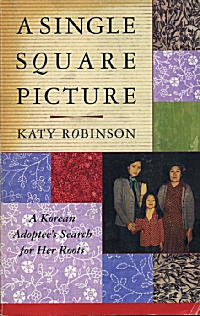
A Single Square Picture:
A Korean Adoptee’s
Search for Her Roots
by Katy Robinson
Berkeley Publishing Group, 2002
Reviewed by Barbara Free
The title of the book refers to a picture of the author and her mother and grandmother, a small Polaroid picture taken just before she got on the plane. She took the picture, and a few other pictures, with her on the plane. As a seven-year-old, making that journey into the unknown, she was scared, but thought she would soon be returning to her family in Korea. This belief has not been explored very often with other internationally adopted children who were old enough to talk at the time of the adoption, and might be an important topic for adoptive parents to discuss with their adoptees, whether they are now adults or still children at home.
Finding out the truth about both her birth father and her birth mother, and their families, proves very difficult, as she hears different versions of who they are and where they are, from different family members, even different versions at different times from the same people. Unlike a novel, this true story does not have all the loose ends brought together, all the facts known at the end of the book. Her journey shows us over and over how important the truth is, no matter whether it is pleasant or not. In trying to find her family, and learn the truth about them, she also finds her own deeper self, and learns much about herself. The reader hopes for a sequel, to learn the rest of her story when the author finds out more.
This book would be an excellent book for any internationally adopted person to read, from adolescence on, and probably should be required reading for all adoptive parents, particularly those adopting Asian children. Adoptees, even Anglos adopted by Anglos, will be able to identify with her mixed feelings during her childhood and her search, and both birth parents and adoptive parents will find elements of their own stories in this book, regardless of their own particular journey. The reader should set aside a day or so to read the book, because it’s a can’t-put-it-down type of story.
Excerpted from the April 2003 edition of the Operation Identity Newsletter
© 2003 Operation Identity